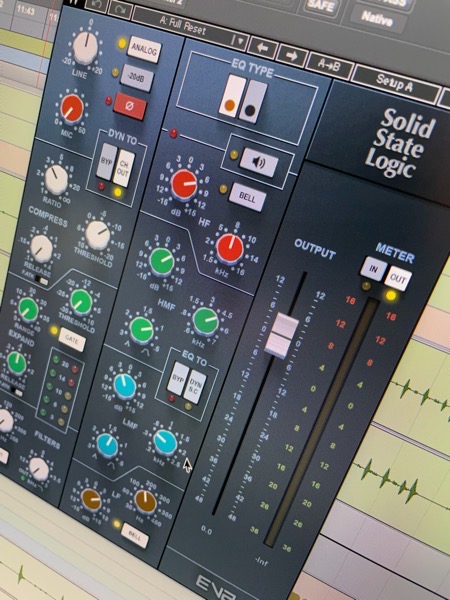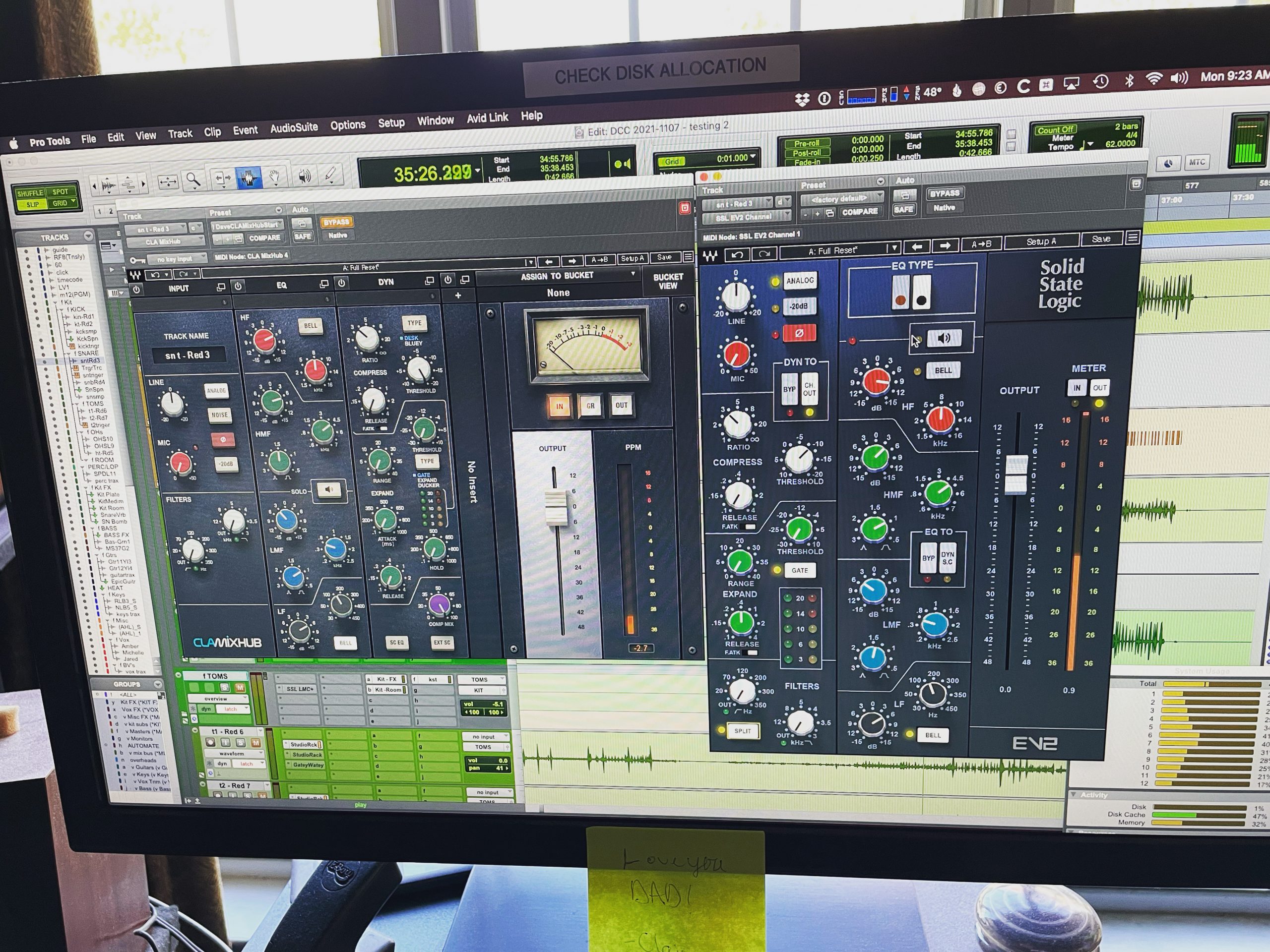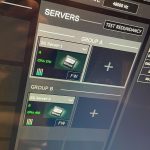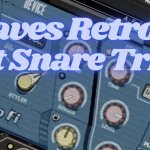
Comparing the New to the “Old”
CLA MixHub has been my go to SSL style emulation plug-in since it was released. It’s been on pretty much every full band mix I’ve done in my studio since then, and Waves even included some presets from me in it. I switched to it from the original Waves SSL Channel plug-in because I thought it sounded better.
This week Waves released a new SSL style plug-in called the SSL EV2 Channel, and it seems to be the true heir to the original SSL Channel plug-in. As an SSL channel fan you knew I was going to pick it up, right?
I compared it to MixHub on some mixes and analyzed it a bit in my “lab”. So here’s what I found comparing EV2 to Mixhub.

First up, let’s look at the “analog” input side. It’s a little different in harmonic behavior in EV2. When I’m talking about harmonics, you can also think of this as “color”, but it’s basically the harmonics that are created from pushing the device. I’m basically putting a 1k tone into the plug-in and looking at an analyzer to see what new harmonics show up for testing purposes.
I wasn’t overly scientific in testing, but EV2 clearly displayed more harmonics right out of the gate while MixHub needed more signal driving in. The harmonic structure was also a little different between the two, and EV2 displayed more harmonic behavior than MixHub as level increased.
This different performance doesn’t mean one is better than the other to me, though. They’re just different like all analog things are. AND it’s a difference that is still going to be pretty subtle for most folks. On EV2, the 2nd order harmonic was ~40 dB down from the test signal. The same 2nd order harmonic was about 60 dB down from the test signal in MixHub. So while that harmonic is louder in EV2, it’s still 40 dB DOWN. All the following harmonics are lower in level as well. So, in practice, that means this kind of thing is going to be subtle to most ears.
Now, this might be the subtlety that makes you prefer one over the other, but it’s not a big deal to me. I like having that console emulation in both plug-ins, but I’m not tied to either one because in the real world I never walk into a situation with multiple desks to choose from. I just use what’s there. Neither of the two plug-ins stood out as sounding “better” to me in this case when I started actually listening. If I really started pushing them I might notice more of a difference, but in a quick A/B on a source it wasn’t jumping out at me. I’m sure someone without actual clients will say differently somewhere on social media, though.
One thing I should point out regarding the analog behavior in pretty much any analog style emulation is it’s all highly dependent on incoming signal levels. You have to drive signal into it to get that color, and more signal is going to give you more color and even sometimes different color. So if you’re a live guy who plays it safe with levels like a lot of the live guys I run into, or worse, doesn’t even look at the signal levels on every input, you’re probably not going to get as much out of this section. It doesn’t hurt with these types of plug-ins to experiment with how much signal you’re putting into it to find the elusive “sweet spot” for something.
Next up: the dynamics section. I hammered a snare drum for testing purposes here, and I didn’t notice much difference sonically when directly comparing only the compressor. The gain reduction meters were slightly different, but if there was a sonic difference it wasn’t enough for me to really pick up on or care about. Most of the differences I heard could be attributed to the natural differences in hitting a snare drum as I flipped between the two plug-ins. I suppose I could have just looped a single snare drum hit, but that’s not realistic to how I actually use anything, and I like testing things more along the lines of how I’ll use it. For me, EV2 is at least as good as MixHub on the compressor front. If I used it for six months and flipped back to MixHub, then I might have more to say.
I didn’t test the Gate because I haven’t been using it lately in MixHub. Historically I’ve liked the SSL channel gate, but in my studio I use something else and in live use I just use the gate on the console. The problem with gates for me right now is I’ve built my own versions within Waves StudioRack, and I’ll never get the same performance from a channelstrip plug-in so I don’t even try.
MixHub’s dynamics section does have some extra dynamics features over the EV2, though. MixHub’s gate controls feature a Hold control along with a Ducker option. The compressor is also switchable on MixHub between the “Desk” compressor and CLA’s “Bluey” compressor. Then there is a “Comp Mix” control on MixHub for in plug-in parallel compression. Oh, and I can’t forget the dedicated EQ just for the sidechain on MixHub.
Now, onto the EQ section. The “Black Knob” EV2 EQ is very very similar to MixHub. I got the low band to null between the two plug-ins, and the high shelf was basically the same on the two plug-ins aside from a maybe 1 dB difference with the same settings. In other words, it seems to be the same EQ curve for the high shelves. That 1’ish dB difference is negligible in my book as my ears would sort that out in practice. The mid bands were slightly different, though, and didn’t null. In practice, my ears sorted this out to, though, but it does mean you can’t just copy settings from MixHub to EV2 and get the same results. You wouldn’t be able to do that on analog consoles, either, though.
Does one plug-in EQ sound better? I’m terrible at answering that question because I don’t really think about EQ’s like that. I can make the EQ on either plug-in work and that’s typically the only thing that matters to me.
Now, the EV2 does add a “Brown Knob” option for the EQ that MixHub does not have. This changes up the slope of the High Pass filter to a more gentler 12 dB/octave compared to the black knob’s 18 dB/octave. The Brown Knob EQ itself is also different and in most cases we’ll get more gain from the black knob version–I had to read the manual to discover this. Sonically, some say the brown knob is more gritty, and the low band and high band have much wider bell settings than the black knob version. The brown knob low band in bell mode reminds me of a Pultec filter in terms of width.
When I experimented flipping between the black and brown knob EQ’s on a snare drum, they were definitely a bit different. After listening for a bit I preferred the brown knob just a bit on that particular snare. The brown knob setting was a little warmer and thicker to me, but I wouldn’t necessarily call the EQ warmer or thicker. The results were just based on the settings I originally dialed in on the black knob. And this is where comparing anything like this gets tricky.
If I had started on the brown knob setting, I might have ended up in the same place as when I started with the black knob. I’ll never know, though. In this particular instance, we also have to keep in mind that there is more gain on the black knob EQ’s. So, when I flip to the brown knob versions I’m getting some very slight gain changes. The sum of those changes might be what appealed to me more because maybe I slightly overcooked things when I initially dialed it in using the black knob. OR it could also be that the low band I was bumping a bit was more appealing to me with the wider Q setting. Either version was a winner for me at the end of the day.
Last up, DSP usage. EV2 used slightly less DSP than MixHub on my system, and we’re talking 1-2% in my DAW’s usage meter. Both plug-ins only use what you turn on, too, which is helpful. In other words, bypassing the input section, dynamics, and/or EQ uses less DSP in both plug-ins.
So, let’s wrap this up. Choosing between these two plug-ins is hard because they are very similar sonically, and I can’t say there’s a clear sonic advantage to one over the other. Personally, I am switching everything over to the SSL EV2 Channel. Here’s why:
My primary use for SSL Channel plug-ins is the EQ. I really like the high shelf on them. I use the entire EQ, but it’s the high shelf that draws me to using them. In addition to the EQ, I also like the compressor on drums because it’s a sound I’m used to on records I enjoy.
The EV2 has the classic E series EQ I like along with the brown knob version I think I’m going to start trying out on snare in lieu of a Pultec. It has a compressor I like, and EV2 is a little more efficient on DSP for me, too, which is another big win.
I think MixHub is still a more powerful plug-in, though. In practice, I just haven’t been using all the extra power like the sidechain features, parallel compression abilities, etc. I never even switch the compressor from the Desk version because I have the CLA76 for that. If I was on a desert island and could only have one plug-in that was either EV2 or MixHub, I’d go with MixHub. In that case, the extra features in MixHub would come in handy for me if it was the only plug-in I had access to.
EV2 feels like a better fit for my current uses, though. It’s a no frills SSL Channelstrip. So my decision right now is more about workflow than sonics. If you’re into SSL style plug-ins, you should check out EV2 and decide for yourself, though.
There’s something else to the EV2 for me, though. I can’t say I have any sort of rationality behind this, but I just really want to use this thing. I don’t know if it’s how good the GUI looks or the sound of it or what exactly it is. Maybe it’s just because it’s something new. Regardless, I just really want to use this thing, and I don’t mean on one or two inputs. I want to do an entire mix with this and not much else. I’m looking forward to using this more and more, and that doesn’t happen with every plug-in I add to my collection.
Have you tried out the SSL EV2 Channel? What did you think?

 Previous Post
Previous Post Next Post
Next Post



My take on it is here: https://penny.cool/waves-ssl-ev2-channel/
Is it OK if I link to your post?
Link away.